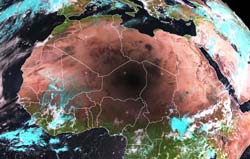Science writer John Horgan has just written a piece about the Templeton Foundation that is causing a bit of a ruckus. It first appeared in The Chronicle of Higher Education, and is also posted a the Edge web-site, where perhaps some further discussion of it will appear.
Horgan participated in a program held at Cambridge as a Templeton-Cambridge Journalism Fellow in Science and Religion, an all-expenses paid gig that came with an additional $15,000 that made it hard to turn down. He had very mixed feelings about the experience, and explains these in detail.
The financial scale on which Templeton operates is unparalleled in this area. As in Horgan’s case, the people they invite to participate in their programs are often offered a lot more money than usual for this kind of thing. The foundation has an endowment of $1.1 billion, and is funding more than 300 projects at the rate of $60 million/year, a rate they intend to double. By comparison, the total NSF budget for supporting theoretical physics is also about $60 million/year. The sheer number and diversity of organizations using Templeton money to promote bringing science and religion together is staggering. I keep finding new ones at various places around the web, and also have yet to run into any organization trying to bring religion into science that isn’t getting Templeton funding.
One new Templeton-funded project is called Foundational Questions in Physics and Cosmology, and has a very illustrious advisory board of physicists. It has just finished accepting proposals for a first round of grants to total $2 million, and has received a 172 proposals, totalling $23 million, from top institutions including Caltech, Harvard, MIT, Princeton and The Institute for Advanced Studies, Stanford, UC Berkeley, Oxford, and Cambridge. Sean Carroll (who turned down Templeton money since he disagrees with what they are trying to promote) has a posting about this, including a guest blog entry and discussion with Anthony Aguirre, who is one of the physicists running the project.
The ethical questions involved in the question of whether to accept money from a source one is not completely happy with are not at all straight-forward. One can sensibly argue that there is nothing wrong with taking money from someone whose goals one disagrees with, as long as they let you do what you want with it, and one isn’t forced to further such goals. On the other hand, publicly associating oneself with an institution to some extent lends ones credibility and prestige to the institution and inherently furthers their goals. It’s also true that money talks, and a large amount of money talks loudly. Many scientists in recent years have probably ended up doing one thing or another that they wouldn’t otherwise have bothered to get involved in because Templeton money made it rather attractive.
There seem to me to be several different things about Templeton to be wary of. One is that the foundation’s leader, Sir John Templeton, is in the process of turning over control of the organization to his son, John Jr., who has a much more politically right-wing, evangelical Christian, point of view than his father. Even if one has no problems with what the foundation has done in the past (e.g., it has not supported creationism), this doesn’t mean it won’t change what it does in the future.
I personally happen to think that bringing religion into physics is inherently a bad idea. Whatever one’s view of religion is, it is inherently a quite different thing than science, and at a time when standards of what is science and what isn’t are under attack, a blurring of the distinction between science and religion may be very dangerous. Much of what Templeton supports seems to me rather silly, but not much of a threat to anything important. For example they are funding a project in Vienna that will bring together physicists, philosophers and theologians to study the foundations of quantum physics. I don’t believe the theologians will be much help here, but they’re not likely to cause much harm. On the other hand, the large amount of Templeton funding promoting symposia devoted mostly to pseudo-science like this one on the Multiverse and String Theory is much more worrying.



